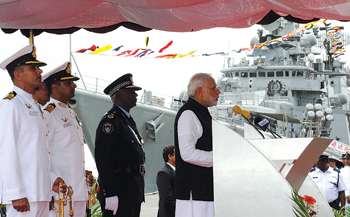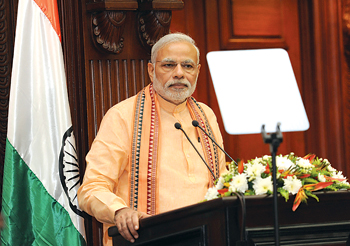INDIAN ARMED FORCES CHIEFS ON OUR RELENTLESS AND FOCUSED PUBLISHING EFFORTS

The insightful articles, inspiring narrations and analytical perspectives presented by the Editorial Team, establish an alluring connect with the reader. My compliments and best wishes to SP Guide Publications.

"Over the past 60 years, the growth of SP Guide Publications has mirrored the rising stature of Indian Navy. Its well-researched and informative magazines on Defence and Aerospace sector have served to shape an educated opinion of our military personnel, policy makers and the public alike. I wish SP's Publication team continued success, fair winds and following seas in all future endeavour!"

Since, its inception in 1964, SP Guide Publications has consistently demonstrated commitment to high-quality journalism in the aerospace and defence sectors, earning a well-deserved reputation as Asia's largest media house in this domain. I wish SP Guide Publications continued success in its pursuit of excellence.
- Appointments Committee of Cabinet approves one-month extension in service of Chief of the Army Staff
- Admiral Dinesh K. Tripathi assumes Command of the Indian Navy as 26th Chief of the Naval Staff
- Prime Minister witnesses 'Bharat Shakti' – a Tri-Services Firing and Manoeuvre Exercise in Pokhran, Rajasthan
- Interim Defence Budget 2024-25 — An Analysis
- Union Defence budget 2024
- Prime Minister Modi Commemorates Indian Navy Day in a Grand Ceremony
Focus — Indian Ocean

Modi became the first Indian Prime Minister to visit Sri Lanka in 28 years – an irony of our foreign policy deficit.
Prime Minister Modi had corrected India’s fixation with its ‘Look East’ policy at the cost of our immediate neighbours when he invited all the SAARC heads to the swearing-in of his government. Acknowledging the strategic significance of the Indian Ocean and its primacy for India’s security and for maintaining peace and stability in the region, he then visited Australia and Fiji. Many would not know that years back when 3,500 Indian families were eased out from Fiji through anti-India feelings generated by inimical forces, equal number of Chinese business families had quietly moved into Fiji. Prime Minister Modi has deepened the focus on the Indian Ocean region (IOR) through his recent visit to Seychelles, Mauritius and Sri Lanka. As a consequence of these visits, India has bagged ‘infrastructure development rights’ for two islands in the region: ‘Agalega’ from Mauritius and ‘Assumption’ from Seychelles.


Signing of agreements with Mauritius included: MoU in the field of ocean economy; programme for cultural cooperation for the period 2015-18; protocol for the import of fresh mangoes from India; MoU for the improvement in sea and air transportation facilities at Agalega Island of Mauritius, and MoU on cooperation in the field of traditional system of medicine and homeopathy. These agreements would enable setting up and upgrading infrastructure for improving sea and air connectivity at the outer island of Mauritius to ameliorate condition of inhabitants and enhance capabilities of the Mauritian defence forces, and; extensive framework for cooperation in the field of ocean economy for mutually beneficial cooperation for exploration and capacity development in the field of marine resources, fisheries, green tourism, research and development of ocean technology, exchange of experts and other related activities.
During the Prime Minister’s visit to Mauritius, the India-built offshore patrol vessel (OPV) Barracuda was commissioned into the National Coast Guard of Mauritius. In his speech Prime Minister Modi thanked Mauritius for choosing India as partner and drew attention to the importance of the India Ocean by saying, “Today, the world speaks of 21st century driven by the dynamism and the energy of Asia and the Pacific. But, its course will be determined by the tides of the Indian Ocean. This is why Indian Ocean is at the centre of global attention more than ever before ….Our vision for Indian Ocean region is rooted in advancing cooperation in our region; and, to use our capabilities for the benefit of all in our common maritime home.” He also talked of terrorism, sea piracy, tsunamis, cyclones, illegal fishing and oil spills, all requiring close cooperation to share responsibilities and shape the future for ensuring a safe, secure and stable IOR that delivers us all to the shores of prosperity.
Prime Minister Modi was also to visit Maldives during this tour as per original plans but this had to be shelved because of the instability in that country as a result of the arrest of former President Mohamed Nasheed who now is reportedly facing a long prison term. Nasheed’s trial is purportedly being conducted on dubious charges and the Commonwealth Ministerial Action Group (CMAG) is contemplating to place Maldives on the formal agenda over former President Mohamed Nasheed’s trial on terrorism charges. The importance of the Maldives lies in its strategic location in the Indian Ocean, astride three of the most important sea lanes of communication, through which most of India’s trade and oil requirements pass, apart from its close proximity to India. Maldives has been going down the road of radicalisation over the past decade with youth going to LeT training camps in Pakistan. Currently, many Maldivian youth have joined the ISIS and some have been killed fighting as well. The present Maldivian Government has recently enthusiastically endorsed China’s proposal for the Maritime Silk Road and has offered Chinese companies land on lease.
India has plans to set up ten specialised Coastal Surveillance Radar Stations in the Maldives also but this will perhaps have to wait till Prime Minister Modi can visit Maldives or Maldivian President Yameen visits India. Meanwhile Indian navy ship Gomati arrived in Maldives on March 10, 2015, to take part in a joint surveillance patrol of the Maldives’ exclusive economic zone (EEZ) from March 11 to 16, in conjunction with the Maldives National Defence Force (MNDF) Coast Guard vessels. Indian naval vessels have routinely conducted joint surveillance and anti-piracy patrols with the MNDF coastguard.
Going to Sri Lanka, Modi became the first Indian Prime Minister to visit Sri Lanka in 28 years – an irony of our foreign policy deficit. Six CSRSs are presently functioning in Sri Lanka, allowing it to identify vessels sailing past the island adding up to collective monitoring capabilities in conjunction wiith the Indian Radar Network in southern parts of India. Sri Lanka released 86 Indian fishermen just before the visit of Prime Minister. Modi addressed the Sri Lanka Parliament urging cooperation in all fields including in countering terrorism and India’s help to Sri Lanka in developing Trincomalee as a petroleum hub. Modi also visited war-torn Jaffna after briefly visiting Anuradhapura and Talaimannar, flagging off a train service at the latter.
India has been pressing Sri Lanka to implement the 13th amendment on devolution of powers in ‘letter and spirit’ and to fulfil the aspirations of the ethnic Tamils. The 13th Amendment that followed the Indo-Sri Lankan Accord of July 1987 signed between then Prime Minister Rajiv Gandhi and then Sri Lankan President J.R. Jayewardene envisaged the devolution of powers to the provinces in the midst of the island’s bitter ethnic conflict. At Jaffna, Prime Minister Modi handed over 27,000 houses built with Indian assistance to displaced Tamils. Trade-wise, Sri Lanka is India’s largest trading partner country in the SAARC region. The bilateral trade between India and Sri Lanka has grown four times in the last nine years increasing from $658 million in 2000 to $ 2,719 million in 2009. The main Indian exports to Sri Lanka are petroleum (crude & products), transport equipments, cotton, yarn fabrics, sugar, drugs pharmaceuticals and fine chemicals. The main Sri Lankan exports to India are spices, electrical machinery except electronic, transport equipments, pulp and waste, natural rubber and paper board. Sri Lanka looks to investments from China as well and should be able to balance friendly relations with both India and China, which should be fine as long as Chinese actions do not amount to strategic muscle flexing.





